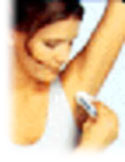http://www.newscientist.com/news/...
| | -Click here for more articles like this. |
 Frequent underarm shaving combined with deodorant use might increase women's
chances of getting breast cancer, claims a study based on a survey of over
400 women with breast cancer in the US. It is the first evidence of such a
link to appear in a peer-reviewed journal, but it is far from conclusive.
Frequent underarm shaving combined with deodorant use might increase women's
chances of getting breast cancer, claims a study based on a survey of over
400 women with breast cancer in the US. It is the first evidence of such a
link to appear in a peer-reviewed journal, but it is far from conclusive.
Claims that deodorants cause breast cancer hit the headlines recently when Phillipa Darbre of the University of Reading in the UK published a paper reporting that preservatives used in antiperspirants and deodorants can be found in breast tumours. But this in no way proved that the preservatives, called para-hydroxybenzoic acids or parabens, actually caused the tumours, and most deodorants no longer contain any parabens.
The US study, by Chicago doctor Kris McGrath of Northwestern University,
does suggest that deodorants or antiperspirants might be linked with breast
cancer, but only together with underarm shaving. And it has too many
weaknesses to be regarded as definitive.
The issue first gained publicity in the 1990s when a hoax email was widely
circulated. It claimed that underarm shaving creates tiny nicks, allowing
unnamed chemicals from deodorants or antiperspirants to enter the body and
trigger tumours.
The first, and until now only, epidemiological study was published in 2002.
Dana Mirick's team at the Fred Hutchinson Cancer Research Center in Seattle
included questions on underarm shaving and deodorant use in a study
comparing 800 women with breast cancer with 800 randomly chosen women of
similar age. Mirick found no evidence of any link.
Age related
McGrath's study, published in December, was smaller. He divided 437 breast
cancer patients into four groups depending on how often they shaved and
applied deodorant. He found that the more zealous the underarm regime, the
younger the women were when diagnosed with cancer.
Those who shaved at least three times a week and applied deodorant at least
twice a week were almost 15 years younger when diagnosed than women who did
neither (European Journal of Cancer Prevention, vol 12, p 479).
Neither shaving nor deodorant use alone was linked with a younger age of
diagnosis. McGrath suspects the aluminium compounds found in many products
might be to blame.
But Mirick says McGrath's study has major limitations. The most serious is
the absence of a control group without breast cancer, she says. That means
there could be a simple explanation for the findings: younger women use
antiperspirant and shave more often than older women.
Hygiene regime
McGrath admits that the study's power is limited. But he claims it is the
first to address the intensity of underarm hygiene regimes. "If a disease
is
from a lifestyle, those exposed to that lifestyle more should have an
earlier diagnosis than those less exposed. For example, the more one
consumes alcohol the sooner an alcohol-related disease should appear,"
McGrath says.
"It is a landmark publication because it provides the first epidemiological
evidence for a link between the use of antiperspirants/deodorants and breast
cancer development," claims Darbre.
Like Darbre, McGrath speculates that the steady rise in the incidence of
breast cancers could be linked to deodorants. But in fact the rise in
underarm deodorant use seems to parallel or even lag slightly behind the
cancer rise, says David Philips of the Institute of Cancer Research in
London -- the opposite of what you would expect if there was a link.
Darbre cites as another cause for concern the fact that over half of breast
cancers occur in the part of the breast nearest the armpit. But sceptics say
this is because that quadrant has the largest amount of breast tissue.
Mirick's work has convinced most experts that there is nothing to worry
about. But McGrath and Darbre argue that their studies provide enough
evidence to justify funding bigger and better studies.
Journal reference: European Journal of Cancer Prevention (vol 12, p 479)
| | -Click here for more articles like this. |